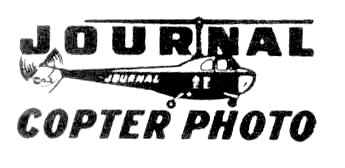Before Sky 8...
Before News Chopper 6...
Before Air 12...
There was the Newsroom Dragonfly.

It was purchased by the Oregon Journal in 1947, the first helicopter in the country used by a newspaper for news coverage.
A state wide news sensation, its career was tragically cut short after less than a year.

The media wars in Portland during the postwar era were between the staid, established Oregonian, the morning paper, which proudly proclaimed itself an "Independant Republican Newspaper" on its editiorial page, and the scrappy blue-collar afternoon paper, the Oregon Journal.
The Journal was founded in 1902 by C.S. Jackson. It often espoused populist causes such as the direct election of
In 1947 the paper was published by Phillip Jackson, the son of its founder. His nephew, C.S. "Sam" Jackson II, newly returned from wartime naval air service was the associate publisher and general manager of radio station KALE- The Journal.

Sam Jackson pilots the Dragonfly
Phillip Jackson had the idea of purchasing a helicopter for the Journal after he had read an advertisement by Bell Aircraft Company in October 1946, but it was Sam Jackson was the prime mover behind the project.
It was an instant success, a news story in itself as well as a revolutionary news gathering tool. Launched from the helicopter pad from the Oregon Journal’s huge building (the former Public Market) on the waterfront, it could reach stories around town in minutes, covering fires (even one at the
The helicopter was so popular the Oregon Journal published a book, “The Newsroom Dragonfly” to be out in time for Christmas, 1947. The book was not lacking in descriptive metaphors for the new technology. Besides "dragonfly" it was referred to as an "eggbeater," "the flying pollywog" (it was green), a "strange new air machine," "doodlebug" and "the airplaine that stands still."
The following photos, from “The Newsroom Dragonfly,” by C.S. Jackson and Joe Stein, present a unique view of



Looking east at Sullivan’s Gulch and

The brand new sternwheeler tug "Portland" assists the retired escort carrier USS Admiralty Islands (CVE-99) through the Hawthorne Bridge on its final journey to Zidell Machinery and Supply Company;s yards (near today's South Waterfront development) for scrapping.
The life of an escort carrier (essentially a freighter with a flight deck) was short even if it survived the war.
The USS Admiralty Islands was launched at the Kaiser Shipbuilding Company yards in

The three locations of the
#1 The Goodnough Building was the papers home from 1902 to 1912. Located across the street from the Pioneer Courthouse, it was torn down along with its neighbor the Corbett Building to make room for Pioneer Place mall.
#2 Jackson Tower, the papers home from 1912 to 1947. It still stands today, beside Pioneer Courthouse Square.
#3, the former
 Fire at the Oregonian!
Fire at the Oregonian! The

The
On the afternoon of Sunday December 21, 1947, Sam Jackson and his friend, businessman Ambrose Cronin Jr. (himself a grandson-in-law of the Oregonian’s founder Henry L. Pittock) left a luncheon at the Cronin household along side of the West Hills golf course (the course was later made the location of the Oregon Zoo in1959).
They drove to the Oregon Journal’s headquarters and boarded the Journal’s helicopter. Jackson and Cronin planned to take pictures of Cronin’s home before returning there for dinner. They took off at approximately 4:10 and flew toward the West Hills.
At 4:30, witnesses reported seeing the helicopter circling the ninth tee of the golf course in a fairly strong head wind when suddenly the tail lifted and the helicopter plunged to the ground. Upon impact, it burst into flames and rolled several times, killing both occupants.

The Oregonian’s front page, Monday December 22, 1947. The Journal's photograph of the crash ran in the papers inside pages. The Oregonian mentioned that the helicopter had been involved in three minor crashes before the final one, information left out in the Journal’s account.
Copies of "The Newsroom Dragonfly" were alrady in the mail to news editors across the nation when the crash took place. A second, "C.S. Jackson Memorial Edition" of the book followed. Every employee of the Journal and KALE radio was given a copy.

1948 was the Oregon Journal's peak year of circulation. Television would soon begin to eat into the newspaper audience, especially in the case of afternoon papers. Upon the death of its founder’s widow, Maria Jackson, in 1961, the Oregon Journal was sold to the publishers of the Oregonian owned by S.I. Newhouse.
Both publications were kept editorially separate until 1982 when the Journal was folded into the Oregonian.

6 comments:
There's nothing I enjoy more than a fascinating account of Portland history. Thank you for sharing the tales and the photos! Much appreciated!
Don't forgot about Channel 2's dual helicopter media stunt.
The pictures are great. Thanks for posting them.
The steam tug in the picture of the carrier going to Zidell's looks a lot like the current Portland, but it is not. It takes a very close look and a good knowledge of the boat, but it looks more like the previous sternwheel tug Portland, the one the 1947 boat was built to replace. The current boat's superstructure is different, and it lacks the rigging that many older boats (and the one in the picture) had to prevent them from sagging at the ends.
My grandfather was piloting the helicopter when it crashed. My father was 5 when he passed. It wasn't until I was about 18 years old did my Dad tell me about his family's rich history!
Tyler. We have something in common. My grandfather was his passenger. So sorry for your loss. I heard Sam was a great guy. They were good friends.
Post a Comment